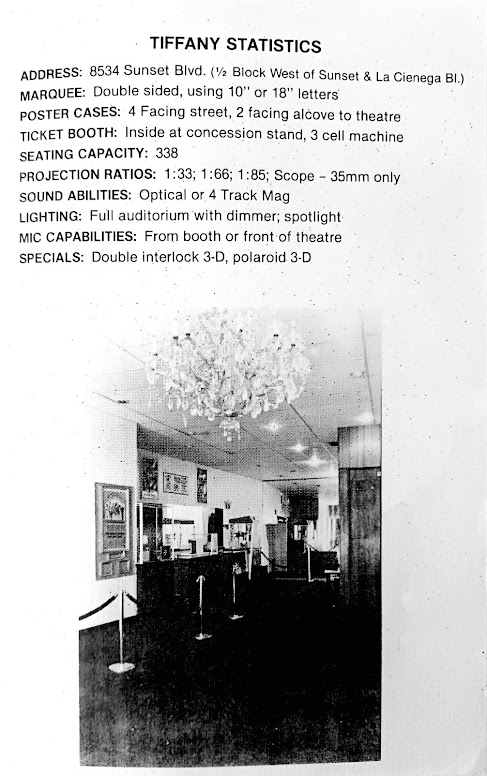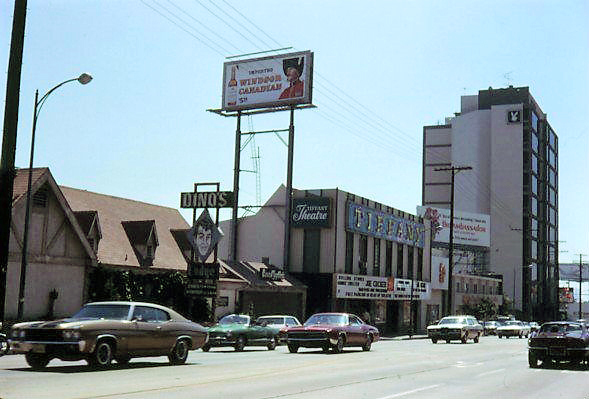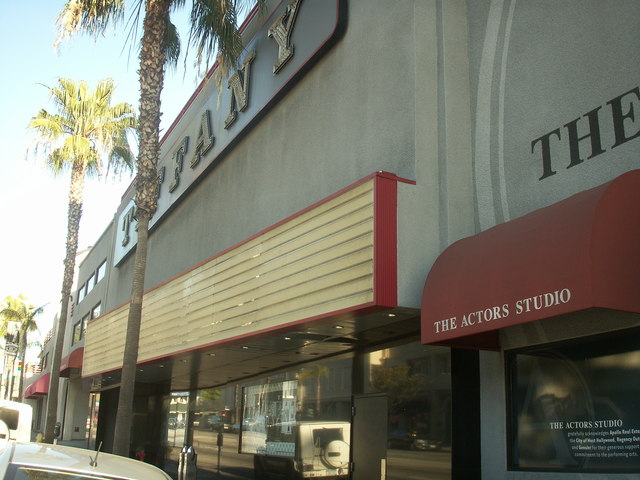8534 Sunset Blvd. West Hollywood, CA 90069 | map |
Opened: November 3, 1966 by producer/exhibitor Robert Lippert
and veteran exhibitor Harold Goldman. The Tiffany was initially marketed as a class venue for foreign films and other specialized product. Thanks to Robert Stone II for sharing this photo he took in 1980. He added it as a comment to a post about the theatre on the
private Facebook group Mid Century Modern. Kurt Wahlner comments:
"I used to manage the Tiff just before this picture was taken. The 2 AM showings were added just in the summers. BTW: We advised Tom Cooper from saying yes to becoming one of the first two theatres in the country to run 'Rocky Horror' at midnight. He booked it anyway!"
Architect: Jack Edwards designed the conversion into a theatre. The building, dating from 1935, had earlier been offices for a modeling school and other tenants. Scott Santoro notes that before the remodel the theatre space in the building had been a photography studio.
A 2013 Laist article noted:
"It started life as an office building, one that was featured in the 1958-1964 television series '77 Sunset Strip' as the office for detectives Efrem Zimbalist, Jr., Roger Smith, and Edd Byrnes. It used to stand between the Playboy Club and Dino's [as in Dean Martin's] Lodge restaurant."
Seating: 388 when it was a single house in its movie theatre days, up through 1983.
"Cinema d'Elegance." It's a November 3, 1966 ad for the grand opening with "Young Aphrodites." Thanks to Mike Rivest for locating the ad. Visit his site: Movie-Theatre.org
An article from Boxoffice magazine about the new theatre. Thanks to Lisa Kurtz Sutton for posting it on the proiate Facebook group
Mid Century Modern.
It's unknown how long Lippert operated the theatre. Beginning in 1968, the theatre had a few live show bookings including a run by the group The Committee. By mid-1971 it was running double features on a 49 cent grindhouse policy. The Tiffany closed in 1972 and stayed dark for five years.
Tommy Cooper arrives: The theatre building, along with other properties on the block, was owned at the time by 20th Century Fox studios. They gave it to Tommy Cooper in a sweetheart deal in 1977 with a rent of $1,000 a month. Cooper also was running the
Vagabond Theatre
on Wilshire at the time and he inaugurated a similar revival policy at
the Tiffany. The Vagabond is now a legit venue/comedy club called the Hayworth.
One stipulation by Fox, according to Tommy, was that he had to try running "The Rocky Picture Show" for at least one weekend of midnighters at a film rental of $0. They were trying to convince him, of course, that it had the potential to turn into something longer running. At the time the only other venue in the country where it was playing as a midnighter was the Waverly Theatre in New York City.
Tommy reopened the house March 16, 1977 with a Sherlock Holmes triple feature: "The Scarlet Claw," "Adventures of Sherlock Holmes" and Sherlock Faces Death." This opening day ad appeared in the L.A. Times.
A Times item appearing on March 24 about the upcoming run of "Kiss Me, Kate!"
"Kiss Me Kate" opened March 30, with stars of the film putting in an appearance. This article by Kevin Thomas appeared in the Times on opening day. Thanks to Scott Santoro for locating this.
A 1977 ad for the "Kiss Me Kate" engagement. Again thanks to Scott Santoro for the research. This was the first of many 3-D films presented at the theatre.
A July 1977 ad for the "First Annual Major Studio 3-D Festival" featuring Columbia releases including "Gorilla at Large," "Inferno," "The Mad Magician," "Man in the Dark" and "Miss Sadie Thompson." Thanks to Mike Ballew for sharing the ad in a
Facebook post. He's working on a book titled "Close Enough To Touch: 3-D Comes to Hollywood."
A ten-week MGM festival opened September 28, 1977 with "An American In Paris" and "The Barkleys of Broadway." This story ran in the L.A. Times on September 26. See
a photo of the opening night of the festival from Tommy Cooper's collection.
The Times ad for September 28. Thanks to Kurt Wahlner for locating it.
An October-November-December 1978 flyer from the Tom Cooper era. Thanks to KPmusmag for sharing it as a post on
Cinema Treasures. KP comments:
"By the way, they did not show 'The Music Man' to my great disappointment - 'South Pacific' sold so well they held it over for that week. The print they had of 'The Sound of Music' was missing the concert version of 'Edelweiss.' It was startling."
"There's a light..." A 1979 "Rocky Horror Picture Show" late night screening at the Tiffany. It's a photo appearing on a
Troy Martin/ Rocky Horror webpage where it's credited as being from the collection of D. Garrett Gafford. The film had it'=s first-run engagement beginning September 26, 1975 at the UA Westwood, the house that ended up as the
Mann Festival.
A 1979 "Rocky Horror" ad from the collection of Lisa Kurtz Sutton.
A May 1980 ad for another 3-D program. Thanks to Ken McIntyre for locating it.
A June 1980 "Rocky Horror" flyer that appears on the Tiffany page of the
Rocky Horror Wiki.
The front of a c.1980 rental brochure that Tommy Cooper did for the Tiffany.
Page two of the brochure.
Page three of the rental brochure. Thanks to Tommy for sharing this from his collection.
A calendar for June, July and August 1982. Thanks to Gary Gibson for sharing this as a comment on a thread about the theatre on the
Lost Angeles Facebook group.
Tommy Cooper ran the theatre until 1983.
Closing as a film house: March 1983. The theatre was remodeled to turn it into two 99 seat legit houses with a reopening in 1985. The north stage reopened October 10 with a production of W. Somerset Maugham's "Rain." In 1997 the building got a more serious remodel with a new second floor and a rebuilt facade.
Status: It closed for good in 2004. At the end it was the home of the Actors Studio. The building was demolished in August 2013. It had been sitting vacant for years awaiting redevelopment plans.
LAist had an August 2013 story about saving the theatre's sign that also included a nice history of the venue.
Interior views:
Tommy Cooper in the lobby. Thanks to Tommy for sharing this photo from his collection. He operated the Tiffany from 1977 until 1983 and continued to run the Vagabond until late 1985.
The lobby shot that appeared in Tommy's rental brochure.
An auditorium view from the brochure.
A lobby photo taken by Jay Goldstein the day before the 2013 demolition. It's one that appears on the Tiffany page of the
Rocky Horror Wiki website.
More exterior views:
1966 - The building before its remodel into the Tiffany. It's a shot by Ed Ruscha in the Getty Research Institute collection.
There over 70,000 Ruscha items now available for browsing. A few places to start:
Sunset Boulevard, 1965-2010, undated (58,167 digitized items) |
Hollywood Boulevard, 1973-2005, undated (4,292 digitized items) |
Santa Monica Boulevard, 1974 (4,956 digitized items) |
Melrose Avenue, 1975 (3,724 digitized items) | Specifically about Sunset Blvd., see the Getty Research Institute's site "
12 Sunsets." Their October 2020
Press Release discusses the project.
1966 - A shot from a seven second clip on the
Getty Images site that they credit to Universal Studios. Thanks to Ken McIntyre for spotting it.
1966 - Another shot from the Getty/Universal clip.
c.1971 - A look west on Sunset Blvd. toward the Tiffany by an unknown photographer. It appears that one of the features was "Joe Cocker: Mad Dogs and Englishmen." Thanks to Alison Martino for sharing the photo from her collection. It was once a post on the Facebook page
Mid Century Modern.
1970s - Dino's Lodge and a bit of the Tiffany. Thanks to Bill Gabel for locating the photo for a post on the
Photos of Los Angeles Facebook page.
1973 - The theatre was dark between 1972 and 1977.
This shot by Ed Ruscha is in the Getty Research Institute collection. The show "The Girl in My Life" ran during the 1973-74 season.
1977 - The opening of a ten-week MGM festival on September 28 with "An American in Paris" and "The Barkleys of Broadway." Thanks to Tommy Cooper for sharing the photo from his collection. See a
September 26 L.A. Times story about the festival and the stars expected to appear opening night.
1978 - The line down the block for a September 15
midnight show of "The Rocky Horror Picture Show." The film "This Special Friendship" got a U.S. release in November 1967. "The Best Way" was out in the U.S. in January 1978. The photo appears on a Troy Martin/ Rocky Horror webpage where they credit it to the collection of D. Garrett Gafford. Jamie Pepper Land also posted a version on the Lost Angeles Facebook group that got many comments. The photo also appears on the Tiffany page of the Rocky Horror Wiki.
1978 - Scott Santoro posted this one on the Los Angeles Theatres Facebook page. The photo also appeared with the August 2013 LAist story about the building's then-impending demolition but has vanished from the version of the story currently online. Scott comments:
"I remember taking that photo. I lived in an apartment building that is now the Mondrian. At the time it was called Park Sunset Plaza and wasn't even air conditioned, but it had great views. It was quite run down. Don Marshall, most famous for 'Land of the Giants,' lived there for a while. After being upbraided by one of the managers, a very plump woman who usually wore a peignoir (!), for not paying his rent, he said to me in the elevator 'What am I doing living in this dump?' But I used to go to the Tiffany all the time. I think I saw almost every 3D movie made in the 1950s. They had a silver screen and since it wasn't very big, the image was very sharp and the 3D was very effective."
Bruce Kimmel notes:
"That double bill opened on November 23 and played four days."
1980 - A view looking down on the Tiffany taken by Lisa Kurtz Sutton that appeared as a post on the private Facebook group
Mid Century Modern.
1980 - A newspaper photo by Doug Tanaka that appeared with the caption "ROCKY HORROR fanatics queue up for another weekend charade at Tiffany's [sic] on Sunset." Thanks to Lisa Kurtz Sutton for sharing the clipping from her collection. She comments: "I was there that night..."
c.1980 - Thanks to Crilly Butler for sharing this one in a post for the
Lost Angeles Facebook group.
c.1980 - "Gimme Shelter" and "Fillmore." It's the photo that Tommy Cooper used on the rental brochure that's reproduced higher on the page.
c.1981 - Thanks to Scott Santoro for this view across toward the rear of the Tiffany. He took it from his
apartment at Park Sunset Plaza (now The Mondrian). It was a post on the
Los Angeles Theatres Facebook page.
2009 - Thanks to Ken Roe for sharing this photo he took in January as a post on Cinema Treasures.
2009 - A photo from Ken McIntyre.
2011 - A Google Maps view.
2013 - Time to rescue the "TIFFANY" letters. It's a photo from Jay Goldstein that appears on the Tiffany page of the
Rocky Horror Wiki website.
The Tiffany in the Movies:
We get this view in
"The Forbidden" (Olympic International, 1966) as part of footage of a riot by teenagers protesting police enforcement of a curfew. On the marquee is the theatre's opening film "Young Aphrodites" and an
added second feature, Bergman's "Smiles of a Summer Night." This
"Mondo Cane" style mock-documentary takes us to nightclubs and other
venues around the world -- wherever there's a chance to show sin and
bare breasts. The film was written and directed by Benjamin
Andrews and Lee Frost. See the
Historic L.A. Theatres in Movies post for views of the Cinematheque 16, Optic, Burbank, Art and Follies theatres from the film.
The Tiffany appears through a window screen in "Point Blank" (MGM, 1967) when Lee Marvin goes
looking for the ex-wife and the buddy who betrayed him. Keenan Wynn is at
the car -- he's after the same guys in the
"Organization." The theatre was running "Eric Soya's 17," the 1965 Danish film
originally titled "Sytten." The east readerboard copy: "For
people over 18. Eric Soya's 17 sparkles.. Like a breath of spring. Park
in Rear. Smoking" See the
Historic L.A. Theatres In Movies post for three more views from the film.
The Tiffany is in the center of the frame as Anouk Aimée, in a white convertible, turns onto Sunset in
Jacques Demy's "Model Shop" (Columbia Pictures, 1969). She's being followed by
Gary Lockwood in his MG. The
film also features Alexandra Hay, Carol Cole, Tom Holland, Severn
Darden and Neil Elliot. The cinematography was by Michel Hugo. See the
Historic L.A. Theatres in Movies post for views of the Coronet Theatre and the Melrose.
We get a look at both the Tiffany and its reflection in this shot from "The Hard
Road" (Four Star Excelsior, 1970). It's a cautionary teen-themed drama
set mostly in Sherman Oaks. We're warned about the evils of drugs and
sex, helped along by animation explaining sex and pictures of diseased
body parts. It was directed, photographed and edited by Gary Graver, who
later worked with Orson Welles. See the
Historic L.A. Theatres in Movies post for another Tiffany shot plus a murky view of the Sunset Theatre on Western Ave. Bruce Kimmel notes that the full film can be seen on
Internet Archive.
David Essex and Ines Des Longchamps drive by the Tiffany in Michael Apted's "Stardust" (Anglo-EMI, 1974;
Columbia,
1975). Thanks to a page about the shooting locations on the site
ReelStreets for the screenshot. It's
the story of a rock singer that also features Adam Faith, Keith Moon,
Rosalind Ayers and Larry Hagman. The cinematography was by Anthony B.
Richmond.
The Tiffany is over on the left in this late night shot from "Vice Squad" (Avco Embassy, 1982). Season Hubley is a single mom working as a prostitute who reluctantly
becomes a police informant. The film also
features Gary Swanson, Wings Hauser, Pepe Serna, Beverly Todd, Nina
Blackwood and Sudana Bobatoon. Gary Sherman directed. The cinematography
was by John Alcott. See the Historic L.A. Theatres in Movies post for shots of the Vogue, Cinema Theatre, Pussycat, Fox, Hollywood Pacific and Pix from the film.
The theatre makes an appearance in "Wavelength" (New World
Pictures, 1983). This science fiction adventure stars Robert Carradine,
Cherie Currie and Keenan Wynn. Mike Gray directed. The cinematography
was by Paul Goldsmith. Thanks to Eric Schaefer for spotting the theatre in the film and getting the screenshot. He comments: "In
this sequence the heroes are transporting escaped aliens along Sunset
Blvd. This movie has yet to receive a proper video upgrade, hence the
poor quality."

Nicolas Cage takes Deborah Foreman across the hill to cruise the sights of Sunset Blvd. and Hollywood in Martha Coolidge's "Valley Girl" (Atlantic Releasing, 1983). Also
featured are Cameron Dye, Heidi Holicker, Elizabeth Daily, Michael
Bowen, Michelle Meyrink, Colleen Camp and Frederic Forrest. The
cinematography was by Frederick Elmes. On the Historic L.A. Theatres in Movies post see another Tiffany view as we approach the entrance, a look at five Hollywood Blvd. theatres plus five shots from scenes at the Sherman Theatre in Sherman Oaks.
More information: See the Cinema Treasures page on the Tiffany. There's a Rocky Horror at the Tiffany Facebook group.
For more about "Rocky Horror" at the Tiffany see the pages curated by Troy Martin. There's also a page about the Tiffany on the Rocky Horror Wiki.
Wikipedia has an article on the Tiffany that lists 3-D engagements and post-1985 live shows at the theatre. There's also an article on exhibitor Robert L. Lippert.
| back to top | Westside theatres | Hollywood | Westwood and Brentwood | Santa Monica and Venice | Westside theatres: alphabetical list | Westside theatres: by street address | Los Angeles theatres - the main alphabetical list | theatre history resources | film and theatre tech resources | welcome and site navigation guide |




















































I took the very last picture of the lobby the day before demolition and have a Joann piece of the black granite facade.
ReplyDeleteHi, Jay -- care to share that lobby photo?
DeleteAmusingly, that photo where Sound of Music is playing is making the rounds and is stupidly dated as 1966. That double bill opened on November 23, 1978 and played four days.
ReplyDeleteI project several of the 3D movies in the 70s. The 2 35MM projectors had to be interlocked so the shutters ran at the same rate. One side had a polarized filter for right eye and one for left. We used 6000 reels which hold about an hour of film. Since we were using both projectors, this necessitated a short intermission in the middle of any 3D film so we could thread up the second half of the film on both projectors. Since you had 2 projectors running, image was quite bright compared to other methiods of running 3D on film.
ReplyDeleteRight. That's the way 3-D was always done originally. A few theatres, like the Hollywood Paramount, had a 4 machine setup so they could eliminate the intermissions. Fun!
Delete